Search This Blog (A.K.A. "I Dote On...")
Friday, March 5, 2010
A Second Stunning North Side Transformation is Now Underway 9:01 AM
Just as the old 14th Street Mall, once in ruins, is being miraculously and meticulously resurrected, so too is Dick Gregory Place in the Greater Ville. Work has begun on several of the 15 historic buildings on a street that Paul Hohmann of Vanishing St. Louis once declared to be "on the brink of devastation". That link contains several photographs of a gorgeous but suffering group of homes that seemed as if its ultimate fate could be nothing other than widespread collapse or demolition. Thanks to the work of the Regional Housing and Community Development Alliance and others, Dick Gregory will now shine as brightly as 14th Street. Two new homes will be added to the mix, as will the renovation of a mixed use building at the corner of Martin Luther King Jr. and Aldine. In total, 40 units will be put (back) on the market.
Matt Fernandez, now Old North St. Louis Restoration Group's Community Development Specialist, provided Urban St. Louis forumers with the following two photos of the commencement of the work. Fernandez assures us the work will be high quality--they're the same contractors that worked to bring back North 14th Street in Old North. Check them out:
Seeing these wonderful North Side preservation successes gives me hope that other forlorn, forgotten neighborhoods and commercial districts of a completely under-appreciated part of our city can return to greatness as well.
UPDATE (3/5/10 @ 10:00am): Rick Bonasch, of RHCDA, dropped a comment on this post with a few corrections and clarifications. Thanks Rick! Check out his blog, St. Louis Rising.
Just for clarification, RHCDA is the development consultant. EM Harris Construction is the General Contractor.
Dick Gregory Associates, LP is the owner. General partners are affilates of Northside Community Housing, Inc and Greater Ville Neighborhood Preservation Commission, both based in the Ville.
The project includes historic rehab of 15 buildings listed on the National Register and 2 new two-unit buildings to be built on Aldine in the District. The new buildings will be at a scale to mesh with the historic buildings.
Thursday, March 12, 2009
Dick Gregory Place in the Ville to Receive Emergency Surgery 11:41 AM
Dick Gregory Place, a National Register District ("Wagoner Place Historic District"), is in an extremely delicate situation, with several buildings at the point of ruins. Nevertheless, RHCDA has assigned itself the daunting task of rescuing 15 of the grand street's suffering structures! They're also constructing two new homes on vacant lots. One building, a small commercial addition to a beautiful Romanesque commercial building at Martin Luther King and Marcus, is slated to be demolished.
All pictures below are screen captures from the linked PDF document.
 |
| From Dick Gregory Pl |
 |
| From Dick Gregory Pl |
 |
| From Dick Gregory Pl |
 |
| From Dick Gregory Pl |
It seems ironic to me that, in a neighborhood plagued with vacancies, this wonderful project that will rescue an extremely fragile historic district must include a demolition--for a parking lot, of all things. And it's difficult to accept the whole "well, it's a great bargain" argument. But, even accepting this as a negative to the project, the whole undertaking is quite impressive and is exciting for a neighborhood inured to demolition and neglect.
With the Ville being one of St. Louis's most culturally significant neighborhoods, and with Dick Gregory Place a highly significant symbol of housing integration within it, the RHCDA must be commended for this project. I especially love how the commercial building on MLK and Marcus is to be restored. Setting this precedent could help to inspire imitators all along the neglected, once busy commercial row.
 |
| From Dick Gregory Pl |
Please explore the Cultural Resources Agenda item for more information.
Sunday, January 25, 2009
In Memoriam: 1709 Annie Malone in the Ville 4:22 PM

This 2007 photograph shows a fairly solid front elevation...

...while the rear elevation can scarcely hide its sorry state.
Yet, somehow, it seems to be not altogether impossible that we could pass by this block today and see a solid facade preserved and lying in wait for someone to construct a shell around the historic street frontage.
Instead, we have this:

Not even the tree could survive in this desolate, deurbanized environment. The building was taken down in September of 2007.
Please, City of St. Louis Building Division, research facade preservation. Other cities do do it!
[Images' Source]
Wednesday, April 30, 2008
Wrong! Tower Grove East takes a punch; the Ville ducks one. 8:45 AM

I made the a prediction in the post that the Flounder house would be saved. Testimony regarding the rarity of these structures in the city, the house's potential to be affordable housing (due to its diminutive size) in a continuously improving neighborhood, etc. would certainly render it safe I thought.
Not so. The Preservation Board approved the demolition 4-2.
Terry Kennedy (18th Ward) was one of those in favor of demolition.
Again, I emailed him. Here is what he had to say:
The overwhelming testimony from the citizens on that block and surrounding community was for demolition. The board heard story after story of the horrors and safety issues living around and near the building. Several of these citizens asked how much longer, after seven years waiting, will they have to wait until this building is demo. The testimony also said this building was extensively marketed as a part of the rehab arama in the area and no buyer and/or developer had come forward. Still further, the proforma presented to the board indicated that it was not cost effective for renovation. There was no real, factual information presented to the contrary. There were two proforma both of which indicating that it was not cost effective. From my recollection, the board was also told that no developer had come forward or would come forward to do the rehab with out large amounts of public funds which was not reasonable.
Quite ironically, my earlier post used the Ville as an example of a neighborhood for which preservation interests were simply not strong enough. But in the latest Preservation Board meeting, it was the Ville's history that was spared and not Tower Grove East's, as I had predicted.
That's right. The demolition of 4568 St. Ferdinand (see earlier post on that as well) was denied.
Are we so shortsighted as to demolish our derelict buildings (rather than secure them; institute a block or neighborhood watch; aggressively market them) when those buildings are rare contributors to our historic built environment?
I can't help but think despite Alderman Kennedy's words that there's a better solution.
Saturday, April 26, 2008
Another attempted Ville demolition. Alderman Moore should go. 9:04 PM
For what reason, you ask? To provide the neighborhood with more green space.
The Cultural Resources Office Report recommends denial of the application to demolish the building at 4568 St. Ferdinand. Kate Shea says that the denial of the request comes in light of a National Register survey being conducted in the neighborhood that is expected to see a 2010 completion. Read the full report here.
The Ville has seen such rampant demolition as of late that it is a wonder anything is left. I'll bet that the National Register of Historic Places is considering booting the Ville Historic District due to too much sacrifice of contributing resources.
Let's see.
- Just a couple days ago, Ecology of Absence reported that a (perhaps very old) Ville frame house was demolished.
- Wagoner Place in the Ville was added to the National Register, but it may be too late. The stately buildings of the once impressive block are in near ruins.
- In October of 2007, three buildings on Annie Malone saw the wrecker thanks to 4th Ward Alderman Sam Moore. In the Ecology of Absence posting, Michael Allen notes that Moore was hostile towards the Preservation Board and vowed to continue to press for demolition of all derelict structures in the Ville.
- In September of 2007, three cast-iron storefronts on MLK met their demise.
- In July of 2007, Sam Moore pressed for the demolition of 39 Ville structures; 11 were approved in a contentious Preservation Board meeting.
- In October 2006, a Classical Revival row at the corner of Sarah and Cottage was demolished.
Those are merely the demolitions that Ecology of Absence has covered; there may be several more.
I wonder if Sam Moore understands that the Ville, the city's onetime premiere African American mecca, will never recover if the neighborhood sees much more of this so called "green space". The last time I checked, very few people seem to relate to a vacant lot on a city block as green space. Sam Moore should block this demolition outright. What are the chances of that, given the history above?
Let's check out the green space the Ville already has to offer.
I didn't even include official green space, such as Tandy Park in the above all-too-easy photo showcase.
Moore's toll on the neighborhood has been devestating. Certainly, vacant structures can be a horrific nuisance. But the Alderman should be working with his constituents to develop a preservation strategy for the neighborhood, highlighting how a historic structure is an investment opportunity, housing a potential income-earning and tax-paying neighbor. But in St. Louis, voters reward the role of the watchdog alderman who does less to develop the neighborhood than to add another layer of policing and ordinance enforcement. See the South Side's Craig Schmid as another example.
Consider, though, the Ville's rich history as the locus of African American upward mobility, culture, and talent, along with its architectural acumen. The Ville is a special case and needs special leadership. It deserves better than this "green space". Unfortunately, it has an alderman more concerned with "Smart Shrink" Youngstown, Ohio-style than making the Ville a sustainable investment once again.
Part of such a strategy involves historic rehabilitation, creative financing, and forging a relationship with constituents that inspires hope for change and growth, not fear of vacant buildings and retrenchment.
And it's not just Moore. If St. Louis's structure of government did not allot so much power to alderpersons, we might see a more citywide vision for redeveloping distressed parts of north St. Louis. Instead, parochialism continues with free reign, further damaging neighborhoods already starved for resources.
The Ville's odds of recovery were already low. With Moore, it will be impossible. Alderman Moore should be recalled.
Tuesday, April 15, 2008
We're not all brick: the Goodfellow-Julian Concrete Block Historic District 5:21 PM
I would recommend reading the National Register nomination (from whence these pictures came) for some invaluable history about concrete block construction in Missouri and St. Louis.
The pictures are from the late 1980s; at least one of the homes has suffered damage from a fire since. The second photo of the set (of 1200 Goodfellow looking northeast) has lost one of its buildings to demolition, confirmed via Maps.Live.Com's bird's eye view.
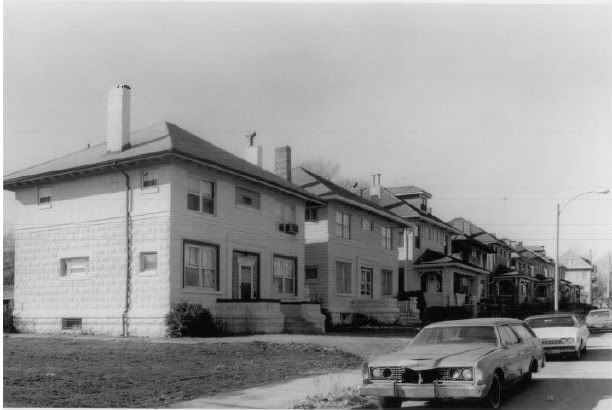
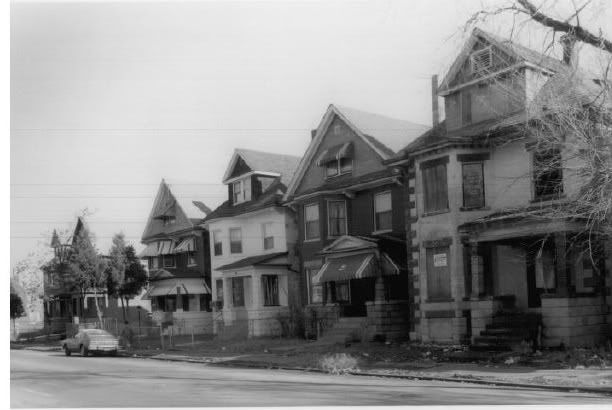
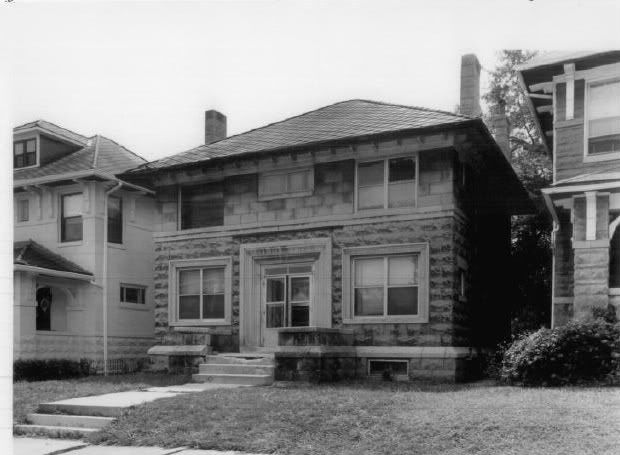
Luckily, the row of Concrete homes on Julian looks mostly intact.
Another great historic resource the city should be guarding with all its political might and yet, look at its condition. Then consider that this is a well maintained district in comparison to demolition-happy Ville, Murphy Blair, and Hyde Park. Of course, it's one block, and it's later construction than the majority of the contributing resources to those districts.
The West End has not been totally isolated from the remarkable turnaround of the East Loop just to the south: near whole blocks of new homes have been erected just north of Delmar in the past couple years. While it's nice that a middle class demographic seems interested in the homes, it'd be even nicer if somehow the spirit of the Concrete Block District (its bold new take on homebuilding at the turn of the century) could have graced the new construction of this century. Instead, vaguely "Colonial Revival" styles dot the cityscape.
Friday, April 4, 2008
M.L.K. Jr.: His Dream, Our Dream 3:46 PM
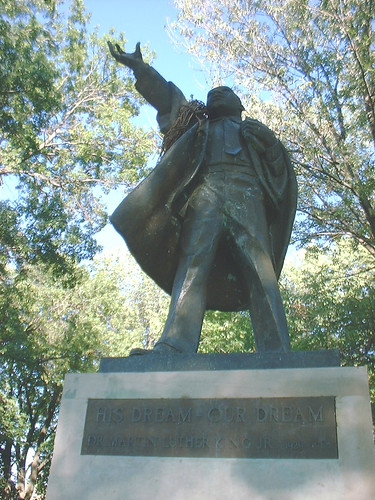
From Fountain Park, on the North Side.
Presidential hopeful Barack Obama's words in his March 18, 2008 speech on race forced the nation to confront its racial rhetoric and paradigms as latent holdovers from a discriminatory and hateful past. Remembering Martin Luther King, Jr.'s death, on this day in 1968, we must absorb the shame-inducing honesty of the Senator's words:
... As William Faulkner once wrote, "The past isn't dead and buried. In fact, it isn't even past." We do not need to recite here the history of racial injustice in this country. But we do need to remind ourselves that so many of the disparities that exist in the African-American community today can be directly traced to inequalities passed on from an earlier generation that suffered under the brutal legacy of slavery and Jim Crow.
Segregated schools were, and are, inferior schools; we still haven't fixed them, fifty years after Brown v. Board of Education, and the inferior education they provided, then and now, helps explain the pervasive achievement gap between today's black and white students.
Legalized discrimination - where blacks were prevented, often through violence, from owning property, or loans were not granted to African-American business owners, or black homeowners could not access FHA mortgages, or blacks were excluded from unions, or the police force, or fire departments - meant that black families could not amass any meaningful wealth to bequeath to future generations. That history helps explain the wealth and income gap between black and white, and the concentrated pockets of poverty that persists in so many of today's urban and rural communities.
A lack of economic opportunity among black men, and the shame and frustration that came from not being able to provide for one's family, contributed to the erosion of black families - a problem that welfare policies for many years may have worsened. And the lack of basic services in so many urban black neighborhoods - parks for kids to play in, police walking the beat, regular garbage pick-up and building code enforcement - all helped create a cycle of violence, blight and neglect that continue to haunt us...
The urban underbelly that so many American citizens are able to shield from their consciousness as "beneficiaries" of exclusionary zoning, superior schools, networks of power, private automobiles, social and physical mobility, trust funds, the "right" way to speak English, a biased legal system, the correct ZIP code, or even just an Anglo name--this is the hour to immerse yourself in the tear-stained truth of the matters of race and poverty in the country. May you never again call any neighborhood with worse-for-the-wear buildings and African-American residents a "ghetto"--thinking somehow that you're superior. Or worse, maybe you think you're lucky to have escaped such conditions. Then why is crumbling infrastructure, contaminated soil, and social isolation okay for those stuck in these ghettos? Abandon all pretense.
Attend church in a neighborhood you were told you'd be shot if you entered it. See what happens.
Walk down St. Louis Avenue from Crown Candy to City Limits, or anywhere in between. See how you feel.
Pull your car over when the police lights flash. When they tell you you shouldn't be up here, do NOT head south.
Stop at a Chop Suey place along Kingshighway, or Natural Bridge, or MLK Jr. Blvd. Or dine in at a fast food restaurant on one of the main drags. Would you eat this every day?
Or simply watch. Watch Fairground Park crumble. Watch McKee own more of St. Louis Place. Watch the Mullanphy Emigrant House struggle to stabilize a piece of history. Watch St. Louis's historic African American community, the Ville, slowly erase its shotgun homes from the cultural landscape. Watch children pack into and pour out of some of the worst schools this nation can present to you. Observe our unique brand of poverty and decay, some of the most notable desolation in the U.S.
But until you do, do not be self-righteous. Do not think you're better. Do not think you're lucky. Do not think it's out of your control. Because the soul of this nation carries these unsightly scars. Do not cake your wound, our wounds in foundation.
Martin Luther King, Jr. had the dream. You, we, I, in his absence, have to act.
Saturday, March 29, 2008
Unique St. Louis architectural style: the free-standing Flounder 4:34 PM
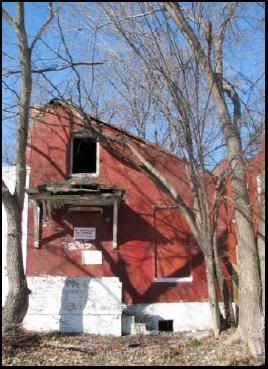
Every once in a while, though, you learn something from giving the neighborhoods around you a closer look. I had never noticed that the building pictured in this post is in fact a style only found in St. Louis: the free-standing flounder building. You may have seen these as back or side units attached to 19th century rowhouses and such (usually with a more steeply pitched half-roof than this one has), but have you ever seen one with street frontage and its own spotlight?
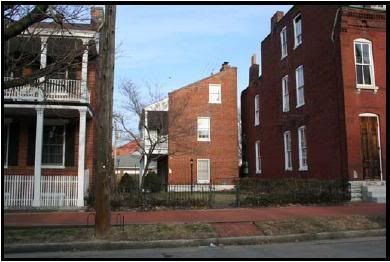
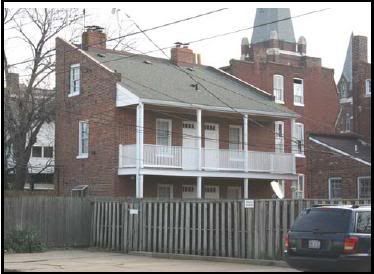
I found this report interesting for two reasons. I loved that this is a unique St. Louis style (who that is not claustrophobic can resist the unbearable cuteness of the rehabbed Soulardian/Bentonian flounders?). And I was also amazed that, as a city, despite our preservation-by-neglect (translation: couldn't afford demolition) approach to the field, people are still, in 2008, willing to see buildings simply removed from the landscape. They would rather have a vacant lot than a potentially tax-paying, living, breathing fellow citizen as a neighbor--architectural admiration issues notwithstanding.
That's the wrong direction for St. Louis. I hope to do an extensive post on the Ville Neighborhood in the future. That neighborhood, the cradle of St. Louis's black culture and our own little "Harlem" of the Midwest, has seen rampant decay and subsequent demolitions. The Aldermen have come and gone, and the buildings have done so more quickly. Horrific, anti-urban infill has popped up and has compromised the context of this all-too-important and historic neighborhood. Enough remains to rebuild the Ville and restore it to its proper prominence, but that is quickly changing at the insistence of its own leadership (as well as the complicity of the other aldermen and the mayor).
Destroying an empty building does not solve the problems of urban neighborhoods; it merely further empties the neighborhood and chips away at extant investment opportunities. This makes little long-term economic, ecological, civic, or cultural sense. So why do we do it?
It is more likely that the Tower Grove East flounder house will be saved. It is located in a "viable" neighborhood. But if even it is threatened, this rare and unique style of building, it does not bode well for our more isolated and "written-off" areas such as the Ville, where poor residents who have stuck with the neighborhood are fed the message that if only they can quash these problem properties and see them reduced to rubble, somehow peace will return to their own plots of land.
It's disingenuous, short-sighted, and wrong. St. Louis, to be cliche, deserves better. As do Tower Grove East on the South Side and the Ville on the North.











